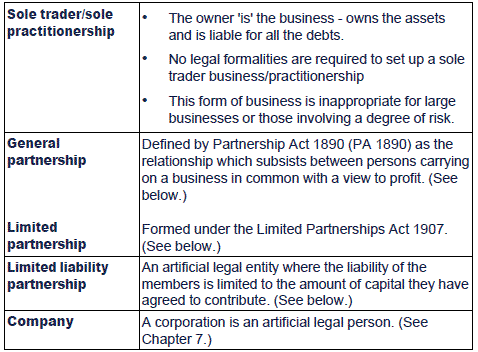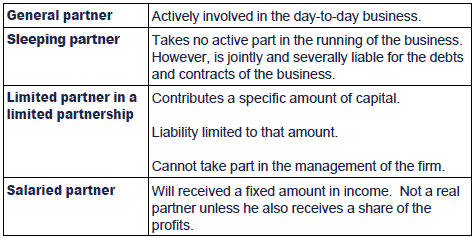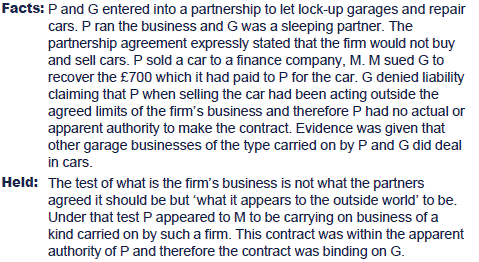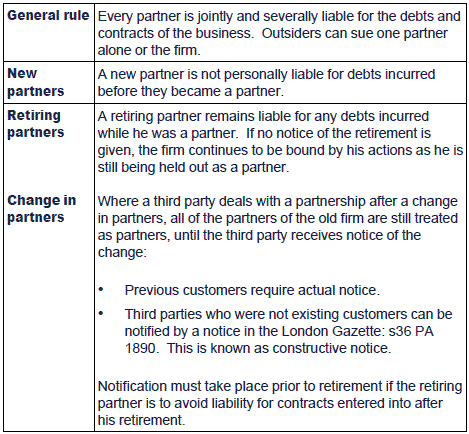Chapter 6: Types of Business Organisation
Chapter learning objectives
Upon completion of this chapter you will be able to:
- distinguish between different types of business organisation
- explain the meaning of the different types of partnership
- in relation to general or ordinary partnerships:
- discuss how they are established
- explain the authority of the partners in relation to partnership activity
- outline the liability of the partners for partnership debts
- explain the ways in which they can be brought to an end.
1 Types of Business Organisation
Different forms of business organisation

The rest of this chapter will focus on partnerships.
2 Types of partnership
Definition
 A partnership is a relationship which subsists between two or more persons carrying on a business in common with a view to profit: s1 Partnership Act 1890 (PA 1890).
A partnership is a relationship which subsists between two or more persons carrying on a business in common with a view to profit: s1 Partnership Act 1890 (PA 1890).
A partnership can be a small operation or as with some large firms of solicitors and accountants partnerships with several hundred partners.
Types of partners

Types of partnership

Characteristics of a partnership
In order for a partnership to exist, a business must be carried on with a view to profit. This means that the persons involved in the partnership intend the business to yield a profit and they are all entitled to share in that profit.
The following do not necessarily create a partnership:
- joint ownership of property
- the sharing of gross returns
- the sharing of expenses.
Cox v Coulson (1916)

A partnership begins as soon as the partners start their business activity. The actual agreement may be made earlier or later than that date.
No formalities are required to form general partnerships, no documentation and no registration. The reason for this is that The Partnership Act 1890 applies to every partnership whether written or oral. Many of the Act's provisions apply, unless they are excluded by a partnership agreement. The PA 1890 provides that partners shall share profits equally, but in cases where partners contribute different amounts of capital this may not be appropriate and partners will need to agree specific profit sharing arrangements within their partnership agreement.
The partnership agreement is a contract. Like any contract it may be:
- express (e.g. oral, in writing or by deed), or
- implied.
The partners are contractually bound by the terms they have agreed, even if they conflict with PA 1890.
Limited partnerships
 A limited partnership is a partnership in which the liability of one or more partners is limited to their capital contribution.
A limited partnership is a partnership in which the liability of one or more partners is limited to their capital contribution.
A limited partnership must fulfil the following conditions:
- There must be at least one partner with unlimited liability.
- The partnership must be registered with the registrar of companies as a limited partnership.
- Limited partners may not participate in the management of the business. If they do, they forfeit their limited liability.
- A limited partner has no power to bind the firm to contracts, i.e. unlike the unlimited partners, he is not an agent of the firm.
3 Authority of partners
Agency relationship
When entering into a contract to carry out the business, each partner is acting as the agent of all the partners:
- The actual authority of a partner is set out in the partnership agreement.
- The apparent authority is set out in s5 PA 1890.
S5 PA 1890 states that every partner is the agent of the firm and of the other partners. This means that each partner has the power to bind all partners to business transactions entered into within their actual or apparent authority.
Apparent authority
Under s5 every partner is presumed to have the implied or apparent authority to:
- sell the firm's goods
- buy goods necessary for, or usually employed in, the business
- receive payments of debts due to the firm
- engage employees
- employ a solicitor to act for the firm in defence of a claim or in the pursuance of a debt.
Trading partnerships
The above implied powers apply to both trading and non-trading partnerships. Partners in trading partnerships have additional powers, such as to borrow money.
In order to be acting within his implied authority, the individual partner must be acting within the usual scope of a partner's powers in the particular business concerned.
Mercantile Credit Co v Garrod(1962)


 Test your understanding 1
Test your understanding 1
Jekyll and Hyde are in partnership providing support services to police services. The partnership agreement states that all scientific equipment is to be supplied by James and that neither partner may incur liability of more than £2,000 without consulting the other. Jekyll, although he contributed all the firm's initial capital, does not have any active involvement and visits its premises rarely. Hyde receives a salary, as well as a share of the profits, and works full-time for the firm.
Jekyll now seeks your advice as he has found out that Hyde has ordered £5,000 worth of equipment from Edgar. Advise him.

4 Liability for partnership debts
Is there liability in contract?
The firm is liable for contracts made by a partner if he was acting within his actual or apparent authority.
The firm is not bound by the apparent authority of a partner if:
- the third party knows the partner has no actual authority, or
- the partner has no actual authority and the third party does not know or believe him to be a partner.
Holding out
Every person who by his words or conduct represents himself (or knowingly allows himself to be represented) as a partner is liable as if he is a partner to anyone who thereby gives credit to the firm: s14 PA 1890.
Martyn v Gray (1863)

Liability in tort
Where a tort is committed during the ordinary course of the partnership's business, or by a partner acting with the authority of the other partners, the partners are jointly and severally liable to the person who has suffered loss.
Misapplication of money or property
The partnership is liable to make good the loss where a third party's money or property is misapplied:
- after being received by a partner within his actual or apparent authority, or
- while it is in the custody of the firm, such as in the partnership bank account.
Which partners are liable?



 Test your understanding 2
Test your understanding 2
Following their earlier dispute, Jekyll and Hyde do not believe that they can continue in partnership. It is proposed that Jekyll will retire and Edgar will be admitted as a partner.
What will be the liability for the firm's debts of (i) Jekyll and (ii) Edgar once these changes have been made?

5 Dissolution
Without court order
The partnership will automatically end in the following situations:
- The expiry of a fixed term or the completion of a specific enterprise.
- One of the partners gives notice (unless the partnership agreement excludes this right).
- Death or bankruptcy of a partner (the partnership agreement will usually make provision for the partnership to continue if a partner should die).
- Where continuation of the partnership would be illegal.
Hudgell, Yeates and Co v Watson (1978)

By court order
Under s35 PA 1890, the court can bring a partnership to an end in any of the following situations:
- Partner has mental disorder or permanent incapacity.
- Partner engages in activity prejudicial to the business.
- Partner wilfully or persistently breaches the partnership agreement.
- Partner conducts himself in a way that it is no longer reasonably practicable for the others to carry on in business with him.
- Business can only be carried on at a loss.
- It is just and equitable to do so.
Distribution of assets
In the event of dissolution the assets of the partnership will be used to pay off the debts of the partnership. As a partnership does not have the advantage of limited liability status, if the proceeds on the sale of the assets does not cover the debts then the partners' personal wealth will be called upon to make up the shortfall.
The proceeds from the sale of the assets will be applied in the following order:
(i)paying debts to outsiders:
(ii) paying the partners any advance they made to the firm beyond their capital contribution i.e. a loan
(iii)paying the capital contribution of the partners.
If there is a residue remaining this will be divided between the partners in the same proportion in which they share the profits of the partnership.
In the event that the assets are insufficient to meet the debts to outsiders then profits held back from previous years or partners' capital will be used to make good the shortfall. If these are also insufficient then the partners will individually contribute in the proportion to which they shared in the profits.
6 LLPs
A limited liability partnership (LLP) is a corporate body which combines the features of a traditional partnership with a company.
LLP's are covered in the next chapter once we have covered the characteristics of a company.
7 Chapter summary
Test your understanding answers

 Test your understanding 1
Test your understanding 1
PA 1890 states that a partnership is a relationship which subsists between two or more persons carrying on a business with a view to profit. Each partner is liable for the debts of the firm.
Jekyll is a sleeping partner who takes no part in the running of the business, but he is treated as any other partner with respect to his liabilities.
Hyde is a salaried partner which means that he can run the business. Any act done within the ordinary course of the firm's business is binding on all partners and they are jointly and severally liable for the debts of the business.
When Hyde enters into the contract with Edgar, he is exceeding the actual authority given to him in the partnership agreement. However, the partnership agreement is not a public document and Edgar could not be expected to know of any limitation imposed upon Hyde's authority. In addition to actual authority, every partner has the apparent authority under s5, to enter into contracts on behalf of the business. As long as the equipment could be used in the ordinary course of the business, the contract will be binding on both parties.
When Hyde enters into the contract with Edgar, he is acting in breach of the partnership agreement. Jekyll can sue for breach of agreement and recover damages for any loss he suffers.


 Test your understanding 2
Test your understanding 2
A partner who has retired from the firm is not liable for any debts that arise after his or her retirement. He or she must notify the partnership's usual suppliers of his retirement and make sure that his name is taken off the list of partners including from the firm's stationery. This is actual notice.
A notice should also be placed in the London Gazette to give notice to the persons who have not previously dealt with the firm that he is no longer a partner. This will be constructive notice.
Jekyll will continue to be liable for the debts that arose while he was still a partner. However, it is possible to avoid this by agreement with Hyde, Edgar and the creditors.
An incoming partner is only liable for the debts arising after he became a partner. However, if there is an arrangement with the creditors by which the new partners assume the obligations of the old, Edgar will be liable for the old debts as well. This agreement can be express or it can be implied from the conduct of the partnership.

|
Created at 5/24/2012 3:14 PM by System Account
(GMT) Greenwich Mean Time : Dublin, Edinburgh, Lisbon, London
|
Last modified at 8/21/2012 10:11 AM by System Account
(GMT) Greenwich Mean Time : Dublin, Edinburgh, Lisbon, London
|
|
|
|
 |
Rating
:
|
 Ratings & Comments
(Click the stars to rate the page) Ratings & Comments
(Click the stars to rate the page)
|
 |
Tags:
|
|
|
|
|